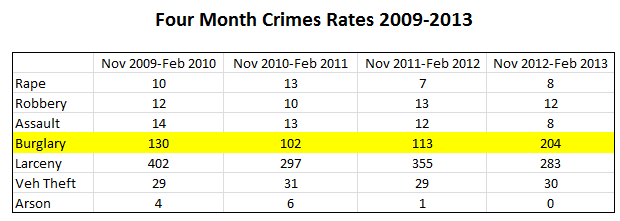 Davis residents have been increasingly alarmed by a string of burglaries this year. A few weeks ago, the Davis Police reported on Sunday, February 10, that four residential burglaries and one attempted residential burglary occurred between 4:30 am and 9:30 pm.
Davis residents have been increasingly alarmed by a string of burglaries this year. A few weeks ago, the Davis Police reported on Sunday, February 10, that four residential burglaries and one attempted residential burglary occurred between 4:30 am and 9:30 pm.
The police at that time reported, “Since January 1, 2013, there are been 41 reported residential burglaries in the City of Davis. The burglaries are taking place citywide and continue to have a pattern of entries being made through unlocked doors, windows, and sliders.”
The police put out a notice, “The Davis Police Department continues to urge people to take these preventative measures to lessen the chances of being victimized: Make sure all windows, doors, garages, side gates, etc. are closed and locked when not in use. It is also suggested, keeping doors locked when you are home.”
They wrote: “This point has been repeated many times before, but DPD continues to see a high number of unlocked entry points among our residential burglaries.”
The police added, “Report any suspicious activity such as persons walking or driving up and down your street, checking for unlocked doors and/or looking in windows, backyards or vehicles. Vehicles ‘cruising’ your neighborhood at very slow speeds or sitting in a vehicle for extended periods can also be signs of suspicious activity.”
Other incidents have alarmed people, as well. On February 23, a woman left her apartment on Alhambra Drive at 5 am when two men grabbed her, forced her inside her apartment and took turns raping her.
Last Friday, at 10 pm, a man ran up behind and grabbed a 17-year-old female who was walking west on Cowell Boulevard near Koso Street.
“The female victim screamed and fought back against the male who had a hold of her shirt,” the Davis Police reported. “During the struggle, the male subject grabbed the female’s buttocks. The female victim continued to scream, and fought back which forced the suspect to flee east on Cowell Blvd. The female ran west on Cowell Blvd. while calling 9-1-1.”
The rash of assaults and burglaries has prompted calls for the city to add police officers, increase patrols, and has spawned calls for neighborhood watches.
Police Chief Landy Black told the Davis City Council a few weeks ago that it is difficult to tell from the data whether we are actually seeing the start of a new trend or whether this is simply a periodic spike. He pointed out that there have been other times in the recent past where there was a rash of crimes, but when examined over the course of a year, crime was actually down overall.
Toward that end, the Vanguard requested data to analyze the current crime trends.

The first chart shows that over the last four years, ending in December of 2012, the key crime stats are actually down in 2012 over previous years. Violent crime hit a five-year low in 2012, as did property crime.
So the question is whether something has changed in January and February of 2013.
To analyze that, we look at four-month intervals since 2009.

What we see are that rape and assaults are actually slightly lower. Larceny is well down, over the peak in 2009-10.
However, burglary has increased, and rather significantly, in the last four months over previous periods.
Police officials told the Vanguard that the recent increase of burglaries follows a fairly typical pattern in Davis, in that we have intermittent spikes in certain types of crimes throughout the year. But by the end of the year, in general, these patterns even out.
It is worth noting that the burglary report that we ran to lead this article came on February 11, nearly four weeks ago, but the Davis Police report that it “appears the South Davis burglaries have come to a stop.”
They say that they have made some unrelated arrests and believe that they got some of those involved in these burglaries.
Police officials are concerned about some the reports, but they believe it is too soon to see what is really going on. In general, they believe that things are no better or worse off than they have ever been in Davis.
Right now, the city’s budget is such that they lack the resources to put additional police personnel on the streets.
The police have noted that many of the burglaries occurred through unlocked doors and open windows, and have urged people take precautions to avoid becoming a victim of what appears to be a rash of easy-access burglaries.
—David M. Greenwald reporting






Thanks for this analysis David. The historical comparison is useful but if spikes are a feature of the data then using the same time frame for each year may not capture that. Whatever the case, I would be intrigued to know the hypotheses that the police put forward for the occurrence of spikes in burglaries/robberies/larceny in particular.
For example, it would seem to me by observation that there is a lot more meth use in Davis right now. Of course I have NO data to demonstrate that. I merely have personal observations. There is evidence that meth purity spikes from time to time and that addictions soar during such spikes. Meth is a relatively cheap drug but is linked to burglary of the type we seem to be seeing a spike in just now. So… is this spike due to a spike in meth use, which in turn is linked to a spike in meth purity or quantity? I doubt there are answers but I would be curious to know what the police think. As I commented a few days ago–meth is one of the most destructive human-created agents I have ever come near and its use leads to the kinds of behavior we are seeing.
I think that Robb raises a very interesting point.
I am wondering if it would not be relatively easy to correlate obtainable data from police records regarding the instances in which the crimes listed above have been associated with meth charges ?
What say you David ?
I can certainly check.
I would be curious to see what the numbers would look like if shoplifting incidents were separated out from burglaries. Since a burglary is something like “entering with the intention of stealing,” shoplifting is often charged as a burglary (a felony) rather than shoplifting (a misdemeanor). Separating these incidents would give a clearer picture of breaking into homes and businesses.
I’d like to see a breakdown by beats. South Davis residents are feeling uniquely targeted with reason, according to the story. Unrelated arrests make me question how long those who may be responsible for residential burglaries will actually be off the streets. Where they’ll go once time is served is anyone’s guess, but there’s no reason to believe South Davis would not be a target, once again. Thanks for following up on this, David.
The police said that all information leads to meth first and prescription drugs second as the underlying problem.
Thanks for checking.
And as an aside, there is a relatively new focus on the increased problem of prescription drug and in particular prescription narcotic related overdoses and death. I anticipate that this will mean, not only within my organization where it is already occurring, but in the prescribing community as a whole, tighter practices in narcotic and controlled substance prescriptions. I don’t know what, if any impact, this will have on drug related crimes, but do see this as an area worth watching.
“all information”? Meaning all crimes have some root cause of meth and/or prescription drugs? I find that hard to believe.
It would also be interesting to compare Davis crime with other cities of similar size. I think we are a ripe target with our population tendency to deny that bad people exist, while being surrounded by large populations of bad people.
The general message from people in law enforcement is that Davis has a lot more crime than most Davis residents want to accept or admit.
Your crime stat charts – convictions, not arrests?
Guilty convictions, or no contest pleas?
Thank you.
Frankly
I don’t think that is what David meant at all. ” All information” is not synonymous with “all crimes”. I interpreted this to mean that all of the information obtainable in which the crime was related to substance abuse, the number one substance was meth and the next most prevalent, prescription drugs. This would make sense given the demographics and known substance abuse pattern of our area.
I also want to use this opportunity to point out an over simplification and framing problem. Using the concept of “being surrounded by large populations of ‘bad’ people leads to a good guy vs bad guy mentality which totally undermines addressing problems from a preventative point of view. Have we not yet learned that labeling as “bad” so that we can lock them up or somehow punish them is not an effective strategy for crime prevention
Thanks for the clarification medwoman.
When I wrote “bad people” I should have qualified it to mean people with a greater tendency to behave badly. This can certainly be a temporary condition. But once a moral compass is turned so that breaking into someone’s house or car to steal is acceptable, it is clear to me that the thief has turned “bad”. Can they adjust their moral compass? Certainly. But few will unless they suffer punishment for their bad behavior.
To clarify here’s the quote from the police official: “However, all reliable information leads to meth being the underlying problem. Several of the large solved strings last year were meth based. One was not really meth, but more opiate based. Meth was the drug of choice, but doing burglaries he was able to get prescription opiates. We are seeing more and more burgs were prescription drugs are taken.”
So does that mean that meth is responsible for all crimes, I can’t say from this information, but my hunch is no.
“The general message from people in law enforcement is that Davis has a lot more crime than most Davis residents want to accept or admit.”
My sense is that Davis is a much safer community than most. When we are in the courts, Davis perhaps accounts for 10 to 20 percent of the cases we cover. The violent crime rate is low.
However, because of that people are a little careless. They leave their door unlocked, windows open and make themselves easy targets. I wouldn’t advise walking alone at night in dark secluded places either.
At the same time, when we hear a lot of these stories we tend to panic a bit and think it means there is an overall trend toward more crime.
The middle ground is better – be safe, take reasonable precautions, understand that crime happens, but don’t panic because despite this we are safer here than most other areas.
JD: the data came from the police, so that would be reported crimes not arrests (you can have a murder but never catch the suspect, that doesn’t mean there wasn’t a murder) or convictions.
Frankly
I agreed with your response right down to the last sentence. “But few will unless they suffer punishment for their bad behavior.” I see no firm evidence to suggest that this is true. What we do know from our recidivism rates is that punishment by incarceration does not seem to promote better behavior. I would suggest that a better approach than punishment would be one that stresses techniques and opportunities that allow the resetting of the moral compass by providing a clear and achievable path to productive contribution to our society. This would only occur when we are willing to focus on prevention and rehabilitation rather than on punishment which from my point of view has been amply demonstrated to be ineffective.
So, if we are speaking “causally”, we don’t have a crime problem, we have a meth problem. We have a problem with an extremely addictive substance. (And before Frankly jumps in to suggest I am exonerating criminals, I am NOT. I am merely pointing out that if we want to deal with the crime we need to deal with the underlying cause of the crime).
So… evidence-based approaches to drug crimes that have been shown to work (reference available) with high benefit to cost ratios include community-based drug treatment, jail and prison-based drug treatment and drug courts. My questions, and I really don’t know the answers, are what community-based drug treatment programs exist in Yolo County, what kind of drug treatment is available in the county jail and does sentencing of those convicted of burglary/larceny/robbery in Yolo county routinely include drug use assessments and, where applicable, drug treatment requirements?
[i]And before Frankly jumps in to suggest I am exonerating criminals[/i]
I wouldn’t suggest that!
I mostly agree with you Robb. Let’s treat the meth problem as the root cause. But we also need to continue to be tough on crime. Meth may be a root cause, but it is no excuse. Meth users are not victims just because the drug is hyper-addictive. It is an illegal substance, so they are criminals just for using. However, it makes complete rational sense to spend more of our resources to help people get off that terrible crap drug for a number of reasons… including reducing crime, but also just from a moral perspective.
One very interesting comment in your law enforcement quote was “We are seeing more and more burgs where prescription drugs are taken”,
I can see a number of possible scenarios here, and thus a number of potential interventions.
Seeing more and more prescription drugs being taken might have a number of implications.
1) Could be due to rising value due to physicians starting to limit their prescriptions. Could be due to people
needing the drugs since no longer able to obtain through prescription for personal use rather than sale.
In either case, the health care community can have an impact by better utilizing non narcotic means for
pain control.
2) Could be due to people changing their recreational drug of choice or mix of drugs for other reasons
unknown to me. Robb, you might have some insight into this area, or the potential for gaining information?
3) If we are seeing a drug “spike” early identification and intervention at the supply level might be helpful as
would more closely targeted prevention strategies.
4) More robust drug abuse prevention and treatment programs are certainly necessary what ever else is found.
5) Also of interest to me specifically will be how the anticipated increased access to health care may affect these
issues. I have seen many women in my own clinic who have delayed treatment of precancerous and even
cancerous conditions because they did not have health insurance but were not “poor enough” to qualify for
adequate government assistance. Although I rarely deal directly with substance abuse issues, I cannot
imagine that people do not make similar choices in this area of health care. I have just one case so share in
this regard ( and am acutely aware that an anecdote does not constitute evidence ) but I think it is just one
example of many.
Years ago an unemployed woman was admitted through the Emergency room to my hospital literally close to
death from alcohol induced hepatitis and alcohol related CNS toxicity ( think dementia but reversible). She was in her 40’s and completely unable to hold a job or provide for herself. Because she had the good fortune to end up in our ER, she was not only stabilized, but admitted for treatment. I got involved as a consultant when she had onset of vaginal bleeding during her stay, which led to the diagnosis of cervical cancer. She was successfully treated for this, as well as for her hepatitis, and treatment of her alcoholism led to reversal of her dementia. The last time I saw her several years later as follow up for her cervical cancer, she was sober, employed in a managerial position with the state and had just received a promotion. Had this woman merely been stabilized and discharged into a community where she had already demonstrated the inability to live as is far too often the case, she would now be dead. We can do better. But only if we are willing to provide comprehensive help instead of merely judging and dismissing.
Frankly
Perhaps you have never broken any law ever. I have. I am guilty of consuming wine before I was above the legal age and have broken the speed limit on a number of occasions. These acts, by your definition render me a criminal. Although I know that the statute of limitations has run out long ago on the former ; )
However, my point is that there is a difference to be made here.
If one speeds a few times, and there are no bad consequences, such as an accident, one can always just quit,
or “reset the moral compass” if you like. This is not true for many people for whom meth addiction can occur after minimal use in terms of times used. This for me is not a question of whether they are a victim, a criminal, a bad person or any other label we might choose to apply. They need our help, medical and societal, and probably for years if they are to successfully break this cycle. They do not need to be “punished” for what has become, because of some very bad choices perhaps made during a time before brain maturation ( commonly referred to as adolescence), the only way they are currently capable of living. If you disagree, please tell me how you believe that punishment benefits the person who is not in control of their behavior ?
Frankly – I was teasing you (thanks for taking it well). I agree that we need to deal with the crime and “being tough” means that accountability structures are critical. For example “flash incarceration” programs whereby people in community-based drug treatment programs are randomly tested and incarcerated as a “wake up call” seem to be showing promise based on evidence. Those addicted to drugs who have successfully participated in such programs talk about how they had “learned” to game most systems but that flash incarceration sets up an accountability structure that is effective because it is “fair” (consequences are stated up front) and systematically used–come up dirty and you are in jail. I am not aware that such programs are in place in our county but they exist.
Interesting hypotheses about use of prescription drug increases medwoman. I am not sure about the “drug of choice” question but I would not call it “recreational”. People are self-medicating–mostly for depression (some of it pretty severe) it seems to me. Again, I don’t have the epidemiology on this but chronic depression is a huge problem for folks in our community. It is quite debilitating and self-medication using a whole range of legal (alcohol) and illegal (prescriptions illicitly come by) is very common.
Here is something to consider. South Davis, where the lion’s share of recent burglaries have occurred is also where most of the “low income” housing has been concentrated.
When the city was pushing to include even more L.I.Housing in south Davis, many south Davis homeowners showed up at city council meetings to give evidence that crimes against them were in fact committed by residents of low income housing units located near their homes.
Of course, the city ( Assistant Chief of Police Steve Pierce in particular) opined that crime was no higher near low income housing installations, in spite of significant evidence tot he contrary. The city pushed through even more low income housing in s. Davis, which has now been built. Look out S. Davis residents.
Robb: [i]”…My questions, and I really don’t know the answers, are what community-based drug treatment programs exist in Yolo County, what kind of drug treatment is available in the county jail…”[/i]
A key question really is: what drug treatment programs actually work; i.e., have a high efficacy, low-relapse rate. Most drug and alcohol treatment programs have very low success rates. So relying on drug/alcohol treatment to prevent crime is not going to be very effective if the programs aren’t working.
Don – I can send you the analysis that I obtained via a link on Max Rexroad’s blog last year (or 2011). It is based on an analysis of programs for which evidence exists. It was done in 2011 by Washington State Institute for Public Policy. Three of the approaches I named above are assessed in it with varying degrees of success based on benefit/cost analysis. I don’t have the details of the data upon which the report was based but they describe their methodology. The point is that the three I named have positive and relatively (to other programs) high benefit/cost ratios and high absolute benefit outcomes. This suggests that such programs “work”. I am not sure how to post this summary study but if you want I can send it to you for posting.
And so, yes, I agree with your point completely. I can only rely on analysis of what appear to be successful programs. I can also send for posting Yolo County’s initial “Realignment” (AB109) Initial Mitigation and Planning for Sustainable Reform document which indicates that some of these programs are in place and have positive influences on recidivism (reducing it). What I don’t know is how implementation or continued use of these programs have gone since realignment actually took effect. Someone might help me with that. I have not had time to check into this.
Robb: Send it to donator@gmail.com and I’ll figure out a way to archive and post it.
Robb
I completely agree with you that my choice of the word “recreational” was unfortunate. When I wrote that what I actually had in mind was the instance of experimentation with parental prescription drugs by adolescents in the home which is a completely different issue. I also agree with you that the bulk of the misuse of narcotics is in an attempt to self medicate whether for physical or emotionally induced pain ( although I think that this is a relatively artificial distinction which leads doctors to under treat and mistreat many patients). And yes, guilty as self charged since we are very far from developing and implementing optimal treatment strategies in my profession.
I also would love to see Robb’s referenced studies.
Here are the studies Robb sent me (pdf):
[url]http://davismerchants.org/vanguard/278_ImplementationPlan_Final_09062011.pdf[/url]
[url]http://davismerchants.org/vanguard/Washington-Public-Policy-11-07-12011.pdf[/url]
David – Thank you for the article and statistics.
Robb via Don — Thanks for the links to the studies.
But . . . I could not get Don’s first link to work.
Yep, sorry, I’ve corrected the URL. Should work now.